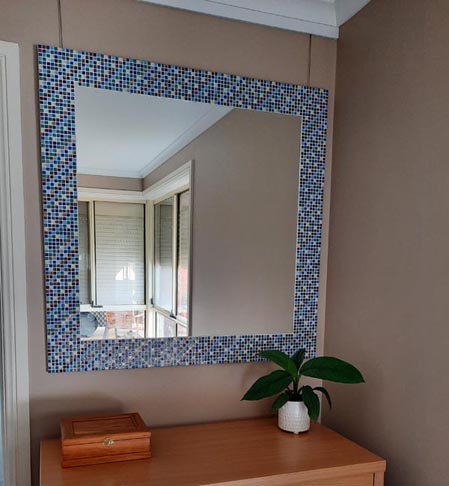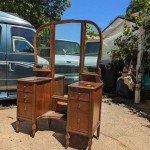Hanging Heavy Mirrors On Brick Wall
Mounting a heavy mirror on a brick wall presents unique challenges compared to drywall. The hardness and often uneven surface of brick requires specific tools, hardware, and techniques to ensure both a secure hold and prevent damage to the wall. This article outlines the necessary steps and considerations for successfully hanging a heavy mirror on a brick.
Assessing the Wall and Mirror
Before beginning, assess the type of brick. Older, softer bricks may require different anchors than newer, harder bricks. Identify if the brick is solid or a veneer. Veneer bricks are thinner and require specific, lighter-weight mounting solutions. Measure the weight and dimensions of the mirror accurately. This information is crucial for selecting appropriate hardware.
Choosing the Right Hardware
The weight of the mirror dictates the type of hardware needed. For heavier mirrors, expansion anchors or masonry screws are recommended. Expansion anchors provide a strong hold by expanding within the drilled hole, while masonry screws thread directly into the brick. Lighter mirrors can sometimes be hung with heavy-duty picture hooks specifically designed for brick.
Selecting the right anchor size is also essential. Consult the anchor packaging for weight limits and recommended drill bit sizes. Choosing an anchor with a higher weight capacity than the mirror's weight provides an added safety margin. Consider the material of the anchor. Stainless steel anchors are highly resistant to corrosion and are generally preferred for exterior applications or areas with high humidity.
Gathering the Necessary Tools
Having the correct tools is crucial for efficient and safe installation. Essential tools include a hammer drill with a masonry bit, a level, a measuring tape, a pencil, safety glasses, and a dust mask. A stud finder can be helpful for identifying mortar lines, which are generally weaker than the bricks themselves and should be avoided when possible.
Preparing the Brick Surface
Before drilling, clean the brick surface with a brush to remove any loose debris or dust. This will ensure a clean drilling surface and improve the anchor's grip. Mark the desired location for the mirror on the wall with a pencil. Use a level to ensure the markings are perfectly horizontal. Double-check measurements to avoid misalignment.
Drilling the Holes
Wearing safety glasses and a dust mask, carefully drill pilot holes into the brick at the marked locations. Use a hammer drill with a masonry bit sized specifically for the chosen anchors. Apply firm and consistent pressure while drilling to prevent the bit from slipping or the brick from cracking. Ensure the holes are deep enough to accommodate the length of the anchors. Clean out the dust from the drilled holes using a brush or vacuum cleaner.
Installing the Anchors and Hanging the Mirror
Insert the chosen anchors into the drilled holes. If using expansion anchors, tap them gently with a hammer until flush with the brick surface. Tighten the screws according to the manufacturer's instructions. Avoid over-tightening, which can damage the brick or the anchor. Once the anchors are securely in place, carefully hang the mirror on the installed hardware. Ensure the mirror sits flush against the wall and is stable.
Using French Cleats for Extra Support
For exceptionally heavy mirrors, consider using French cleats. A French cleat system consists of two interlocking pieces of wood, one attached to the wall and the other to the back of the mirror. This system distributes the weight across a larger surface area, providing a more secure hold. This method requires precise measurements and installation but offers significant added stability for very heavy mirrors.
Alternative Mounting Methods for Lighter Mirrors
For lighter mirrors, specialized brick clips or adhesive hangers may be suitable. Brick clips grip the brick's edges, while adhesive hangers bond directly to the surface. However, these methods are not recommended for heavier mirrors or in areas exposed to moisture or temperature fluctuations. Always consult the manufacturer's weight recommendations before using these alternative methods.
Safety Considerations
Prioritize safety throughout the entire process. Always wear appropriate safety gear, including safety glasses and a dust mask. Use caution when working with power tools and ensure the surrounding area is clear of obstructions. If unsure about any step of the process, consult a professional for assistance. Enlisting professional help may be particularly advisable for very heavy or valuable mirrors.

How To Hang A Heavy Mirror Securely Bob Vila

How To Hang A Heavy Mirror On Brick Fireplace Drill Into Dans Le Lakehouse

How To Hang A Large Wall Mirror Step By Tutorial

How To Hang A Heavy Mirror On Brick Wall Hanging Tips Easy Tutorial Homify

How To Stick Mirror On Brick Wall Bunnings Work Community

How To Hang A Very Heavy Picture Or Mirror The Best

How To Hang A Heavy Mirror On Brick Wall Hanging Tips Easy Tutorial Homify

How To Hang A Very Heavy Picture Or Mirror The Best

How To Hang A Large Or Heavy Mirror

Round 61cm Wall Hanging Large Mirror Industrial Mirrors Metal








